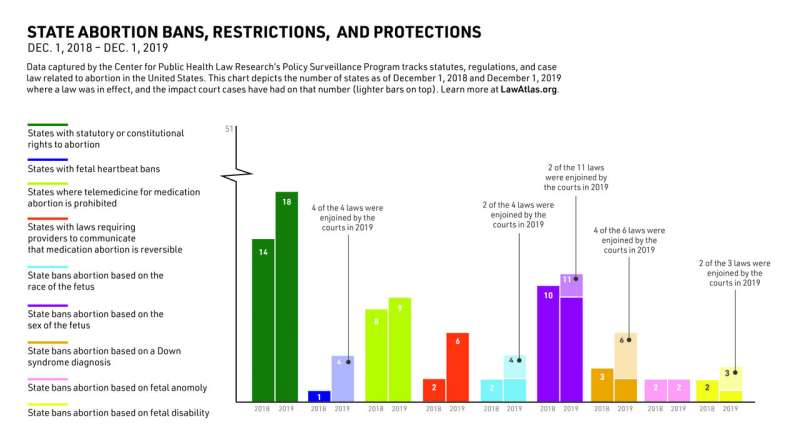Updated abortion law data show an active year for reproductive rights in the US

The landscape of abortion law in the United States saw increase in targeted restrictions in 2019, but also some efforts to protect access by state governments and courts, according to data published today to LawAtlas.org by the Center for Public Health Law Research.
The data capture abortion-focused laws passed in 2019 across 15 topic areas in effect between December 1, 2018 and December 1, 2019. These were either amendments to existing laws, or newly enacted laws passed by legislators. The majority of these laws were efforts by states to regulate abortion further:
- Five states enacted laws banning abortion based on gestational age, including a law in Alabama that bans virtually all abortions throughout pregnancy. Four have been challenged and blocked by courts. The Louisiana law will only take effect if a similar Mississippi ban, current blocked, is allowed to take effect.
- Four states—Arkansas, Kentucky, Missouri, and Utah—enacted targeted "reason-based" bans that prohibit abortion based on the pregnant person's reason for seeking an abortion. These reasons can include fetal disability or anomaly, Down syndrome, or the race or sex of the fetus.
- West Virginia passed a new law prohibiting the use of telemedicine for medication abortion, bringing the number of states with this restriction to nine.
- There were 37 court challenges to abortion bans in 2019 that violated constitutionally established reproductive rights.
"Abortion is currently the most regulated medical procedure in this country, and state legislatures were incredibly active this past year in enacting further restrictions on abortion," said Adrienne Ghorashi, JD, a manager of the Abortion Law Project for the Policy Surveillance Program at the Center for Public Health Law Research. "Some of these restrictions were tested in the courts—and we also saw four states pass measures affirming the right to abortion."
As of December 1, 2019, 18 states—a little more than one-third of all states—have passed statutory or constitutional protections for abortion.
In addition to statutes and regulations, the data released today also track court cases.
"Tracking the case law and its impact on implementation and enforcement of the relevant abortion regulations in the United States provides a more complete picture of what is actually happening 'on the ground,'" said Lindsay Cloud, JD, director of the Policy Surveillance Program at the Center. "This is important not only for practitioners and advocates to understand, but also for researchers seeking to evaluate the impact of these laws on the public's health."
The data were created by the Policy Surveillance Program at the Center for Public Health Law Research in collaboration with subject matter experts from the Guttmacher Institute, Resources for Abortion Delivery (RAD), American Civil Liberties Union (ACLU), Center for Reproductive Rights (CRR), National Abortion Federation (NAF), and Planned Parenthood Federation of America (PPFA), who conceptualized and developed the Abortion Law Project.
These data will be updated again in August 2020. They are presented in interactive maps on LawAtlas.org, which provides free, open-access to more than 120 laws and policies of public health significance.
More information: State Abortion Laws. Policy Surveillance Program at Temple University Center for Public Health Law Research. lawatlas.org/datasets/abortion-laws. Published February 13, 2020.
The Center for Public Health Law Research supports the widespread adoption of scientific tools and methods for mapping and evaluating the impact of law on health. Learn more at phlr.org.

















